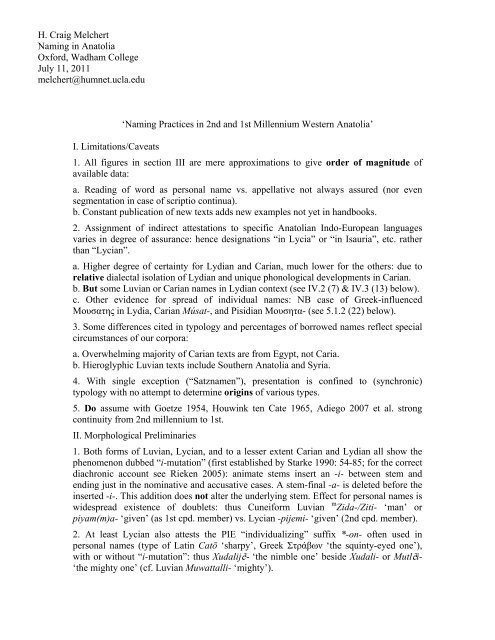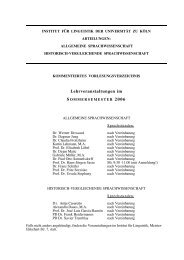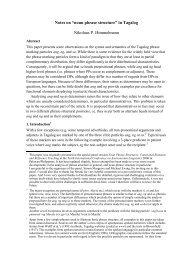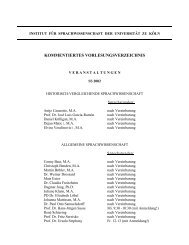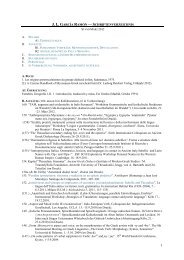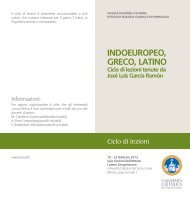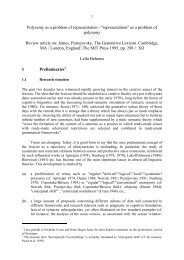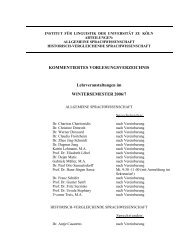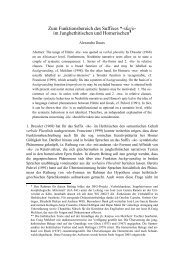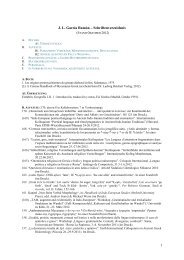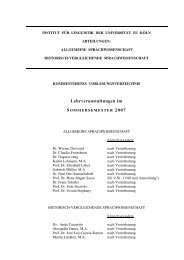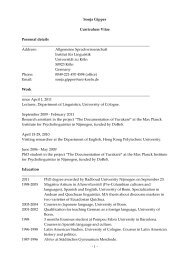Topics in Anatolian Historical Grammar Prof. Dr. H. Craig Melchert
Topics in Anatolian Historical Grammar Prof. Dr. H. Craig Melchert
Topics in Anatolian Historical Grammar Prof. Dr. H. Craig Melchert
You also want an ePaper? Increase the reach of your titles
YUMPU automatically turns print PDFs into web optimized ePapers that Google loves.
H. <strong>Craig</strong> <strong>Melchert</strong><br />
Nam<strong>in</strong>g <strong>in</strong> Anatolia<br />
Oxford, Wadham College<br />
July 11, 2011<br />
melchert@humnet.ucla.edu<br />
‘Nam<strong>in</strong>g Practices <strong>in</strong> 2nd and 1st Millennium Western Anatolia’<br />
I. Limitations/Caveats<br />
1. All figures <strong>in</strong> section III are mere approximations to give order of magnitude of<br />
available data:<br />
a. Read<strong>in</strong>g of word as personal name vs. appellative not always assured (nor even<br />
segmentation <strong>in</strong> case of scriptio cont<strong>in</strong>ua).<br />
b. Constant publication of new texts adds new examples not yet <strong>in</strong> handbooks.<br />
2. Assignment of <strong>in</strong>direct attestations to specific <strong>Anatolian</strong> Indo-European languages<br />
varies <strong>in</strong> degree of assurance: hence designations “<strong>in</strong> Lycia” or “<strong>in</strong> Isauria”, etc. rather<br />
than “Lycian”.<br />
a. Higher degree of certa<strong>in</strong>ty for Lydian and Carian, much lower for the others: due to<br />
relative dialectal isolation of Lydian and unique phonological developments <strong>in</strong> Carian.<br />
b. But some Luvian or Carian names <strong>in</strong> Lydian context (see IV.2 (7) & IV.3 (13) below).<br />
c. Other evidence for spread of <strong>in</strong>dividual names: NB case of Greek-<strong>in</strong>fluenced<br />
Μουσατης <strong>in</strong> Lydia, Carian Músat-, and Pisidian Μουσητα- (see 5.1.2 (22) below).<br />
3. Some differences cited <strong>in</strong> typology and percentages of borrowed names reflect special<br />
circumstances of our corpora:<br />
a. Overwhelm<strong>in</strong>g majority of Carian texts are from Egypt, not Caria.<br />
b. Hieroglyphic Luvian texts <strong>in</strong>clude Southern Anatolia and Syria.<br />
4. With s<strong>in</strong>gle exception (“Satznamen”), presentation is conf<strong>in</strong>ed to (synchronic)<br />
typology with no attempt to determ<strong>in</strong>e orig<strong>in</strong>s of various types.<br />
5. Do assume with Goetze 1954, Houw<strong>in</strong>k ten Cate 1965, Adiego 2007 et al. strong<br />
cont<strong>in</strong>uity from 2nd millennium to 1st.<br />
II. Morphological Prelim<strong>in</strong>aries<br />
1. Both forms of Luvian, Lycian, and to a lesser extent Carian and Lydian all show the<br />
phenomenon dubbed “i-mutation” (first established by Starke 1990: 54-85; for the correct<br />
diachronic account see Rieken 2005): animate stems <strong>in</strong>sert an -i- between stem and<br />
end<strong>in</strong>g just <strong>in</strong> the nom<strong>in</strong>ative and accusative cases. A stem-f<strong>in</strong>al -a- is deleted before the<br />
<strong>in</strong>serted -i-. This addition does not alter the underly<strong>in</strong>g stem. Effect for personal names is<br />
widespread existence of doublets: thus Cuneiform Luvian m Zida-/Ziti- ‘man’ or<br />
piyam(m)a- ‘given’ (as 1st cpd. member) vs. Lycian -pijemi- ‘given’ (2nd cpd. member).<br />
2. At least Lycian also attests the PIE “<strong>in</strong>dividualiz<strong>in</strong>g” suffix *-on- often used <strong>in</strong><br />
personal names (type of Lat<strong>in</strong> Catō ‘sharpy’, Greek Στράβων ‘the squ<strong>in</strong>ty-eyed one’),<br />
with or without “i-mutation”: thus Xudalijẽ- ‘the nimble one’ beside Xudali- or Mutlẽi-<br />
‘the mighty one’ (cf. Luvian Muwattalli- ‘mighty’).


